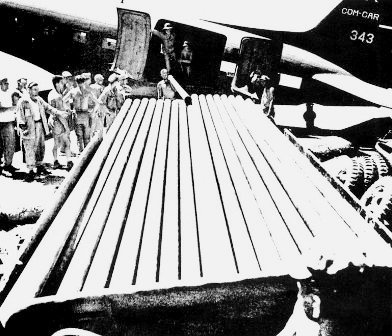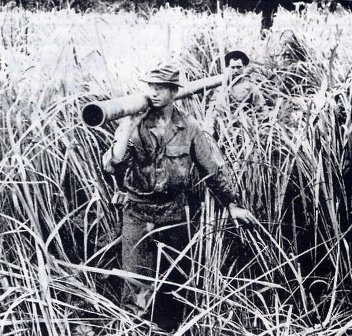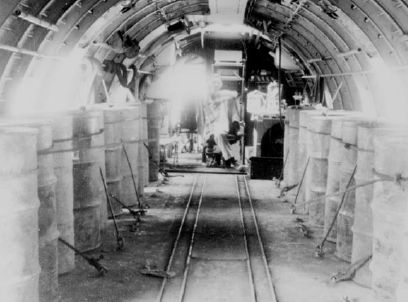In October, 1943, American and Chinese soldiers were slowly pushing the Japanese back through North Burma to
remove the threat of a Jap-Axis link-up across Asia, which would have proved disastrous to the Allies.
American engineers were carving the Ledo Road through the impossible terrain in support of the fighters but even
the road builders needed help. Huge quantities of fuel were needed for the bulldozers, trucks and heavy equipment
engaged in road construction, and by the time the point of the road was at the 50-mile mark, 40 percent of all
transportation over it was trucks supplying this fuel.
 In the wilds of Burma a C-47 delivers a cargo of 4-inch pipe from India for the ABC Pipeline.
In the wilds of Burma a C-47 delivers a cargo of 4-inch pipe from India for the ABC Pipeline.
|
|
The solution to the supply problem was obvious to Col. Lewis A. Pick. The pipeline to China, already
authorized by the Quebec Conference, had to be started to supply troops and road builders in the forward areas.
He gave the orders to begin the ABC Pipeline, the Assam-Burma-China section of the world's longest military pipeline.
Only a handful of specially trained pipeline engineers were available to supervise the work of a
colored engineer construction company assigned to start the line.
These untrained men made up in hard work what they lacked in knowledge, and soon had pushed the line
from the small refinery at Digboi, Assam, to the 35-mile mark on the road.
There they were joined by combat engineers in the task, and when additional pipeline engineers arrived to take
over construction in February, 1944, gasoline was being dispensed directly from the pipeline within a few miles
of the fighting front.
Unfortunately, the trained pipeline engineers arrived along the road far in advance of their regular
equipment. Their welding machines, trucks, and other heavy units were somewhere en route to them along the world's
longest supply line from the States. Undaunted, the engineers borrowed what equipment they could from units working
on the road.
Transportation continued to be the biggest problem for everyone working along the road.
Trucks depreciated rapidly in the heavy hauling they were subjected to over the mountainous roads.
A set of brakes could be expected to last one month, and brake bands were almost unobtainable.
The vital urgency of the job was felt by all who worked night and day to speed the project.
On May 13, 1944, the first aviation gasoline arrived at the strategic airbase of Shingbwiyang, but engineers
did not pause. Another airstrip was under construction a few miles up the road at Tingkawk Sakan, and the
pipeline had to reach there for the opening of the field.
The long heralded monsoon struck in full fury in May and it could not have arrived at a more undesirable
time. Between Shingbwiyang and Tingkawk Sakan road engineers were going about the seemingly impossible job of
bridging the 13-mile swamp, which the monsoon had converted into an inland sea. A one-way causeway was in operation,
but traffic was so heavy that the pipeline engineers could not monopolize its use to get their line built.
They were, however, given a high priority. Working mostly at night they took pipe from trucks moving at
snail speed along the bridge and walked it into position through waist-deep mud and water. The pipe was coupled
from boats and allowed to sink into the morass. When the water receded in December, it was found that the pipeline
was on dry ground, and that the job could have been done under normal conditions in a
fraction of the time it actually took.
Need of the combat troops and road builders took priority on the first shipments of fuel through the line
to Tingkawk. Gasoline and diesel oil arrived there on June 10, relieving approximately 40 per cent of the truck
shipments, which previously had had to battle the causeway bottleneck.
By June 17, 100-octane gasoline was being dispensed to fighter planes, combat cargo planes and bombers at every
airstrip then in the combat zone.
When the pipeline from Calcutta was completed to join with the ABC pipeline, 100-octane gasoline,
which had been flown from the Calcutta terminals, was pumped all of the way through the military pipeline.
Near Warazup, the pipeline and the Ledo Road entered the Mogaung Valley, where jungle vegetation is
reputedly the heaviest in all of North Burma. The rains continued, and for one 45-day period, pipeline engineers
in the area worked 12 hours a day without dry clothing. Few had even a dry bed to sleep in. Keeping personal
equipment usable was one of the biggest problems at this time. A pair of heavy duty army shoes had a life expectancy
of ten days in the mud and water. Jungle boots came apart in less than a week. Clothing mildewed in water-proofed
bags. Finally despairing of keeping dry, the men worked in the rain without being hampered by boots or raincoats.
The insistence of the monsoon and the jungle insects began to take a heavy toll on the health of the men.
Malaria, dysentery, and typhus incapacitated a large number of the workers, but still the work went on.
Suppressive atabrine treatment and rigid malaria control became compulsory, and with its administration the malaria
rate declined until it became negligible. Vitamin deficiencies caused by lack of sunshine and the Spartan diet
imposed by absence of fresh meats and vegetables were partially remedied by the issue of a daily ration of vitamin
tablets.
Leeches became one of the biggest nuisances to plague the workers. When a man stopped for a moment in the
jungle the little creatures literally swarmed over him. One of the standing jokes at this time was that blood plasma
was to be pumped through the pipe line to enable medics to replace the blood taken by the blood-sucking worms.
Stories about snakes and wild animals were legion, but there is no record of a pipeline engineer being
harmed by either. Hunting offered about the only diversion for the men, and many tigers and pythons were killed.
Deer abound in North Burma, and parties were regularly sent out to obtain fresh venison for the mess halls.
 Members of the 776th Engineer Petroleum Distribution Co. plod through jungle grass with a pipeline section.
Members of the 776th Engineer Petroleum Distribution Co. plod through jungle grass with a pipeline section.
|
|
Indian Pioneer troops had been assigned to work with pipeline engineers, and their knowledge of the jungles
made them invaluable to the Americans. They were primarily used to prepare the pipeline trace, but their ability
to catch on to the intricate work soon made it possible for them to be used to supplement the skilled workers
actually engaged in construction.
Fighting for the strategic railhead and supply city of Myitkyina was officially ended on August 3, 1944.
Within nine days a complete petroleum distributing company had been flown into the battered airstrip, and had
received 20 miles of pipe by air.
The taking of the city by the legendary Merrill's Marauders with the assistance of combat engineers and
American-trained Chinese soldiers made possible the final phase of the North Burma campaign. To take full advantage
of the situation, air bases had to be expanded even before the road was completed there. Huge quantities of diesel fuel
and aviation gasoline were needed immediately, and construction of a temporary pipeline offered the best remedy for
the situation.
The Stilwell Road was to be cut through virgin country from Warazup direct to Myitkyina, but at this time it
had not been started. Pipeline engineers began working toward one another from Warazup and Myitkyina, building their
temporary line through Kamaing and Mogaung.
Only a combat trail existed between Warazup and Kamaing, and it was impassable. Water was 4 to 5 feet deep
along parts of the proposed right-of-way. Tractors pulling pipe sleds bogged down, and only pontoons and assault
boats were able to get the supplies into position. Some elephants were used, but they proved unsatisfactory because
of the long trips and the inability of the native handlers to understand the urgency of the work.
Pumps and pipe were sent by pontoon rafts to Kamaing, where two American and some reclaimed Japanese trucks
were available for use. In some places pipe was coupled into 600-ft. sections on dry ground and floated into place.
It was necessary to put a 700-ft. welded section of pipe over the Mogaung River at its highest flood stage.
When the river receded it was found that 70 feet of pipe would have been sufficient under normal conditions.
Diesel fuel arrived at Myitkyina days ahead of schedule and soon 100-octane gasoline was flowing into storage
tanks at a sufficient rate to support the ever-mounting campaign.
While the temporary line was being built, other pipeline engineers, working with the road builders, were
putting in the permanent lines along the shorter new road.
Never was there a pause in construction activities. Even before the road was finished to Myitkyina, pipeline
engineers, getting their supplies by air, were pushing on toward the besieged city of Bhamo. One detachment was
unloading pipe from combat cargo planes on the first day the newly captured airstrip at Bhamo was in operation.
Three days after the fall of this Japanese stronghold, gasoline was being dispensed to trucks, and pipeline
engineers had bypassed the town to continue pipeline construction toward China.
The success of the Northern Combat Area Command in clearing North Burma of Japanese to open the land route
to China was assured, but far from a reality in October 1944, when it was decided to start the pipeline back toward
Burma from the China side. Simultaneous work on the pipeline from both directions was a necessity because the
pipeline engineers could not bypass the men doing the actual fighting.
A small group of pipeline engineers were flown over the Hump to establish an advance pipeline headquarters,
and to prepare the way for large groups of trained pipeline personnel soon to follow.
While ground work was being laid in China, petroleum distributing companies were at airbases in Assam,
dismantling their equipment for air shipment. Soon personnel and supplies began to be flown out, and by mid-November,
over the Hump shipment of personnel and equipment had exceeded 500 tons and was rapidly mounting.
 Completion of the pipeline eliminated the need for dangerous missions flying fuel over the Hump to China.
Completion of the pipeline eliminated the need for dangerous missions flying fuel over the Hump to China.
|
|
In early November, survey parties were sent ou along the Burma Road to determine the best route for the
petroleum life line. At times their work was held up while Chinese expeditionary forces pushed the Japs back toward
Burma. When their work was finished, it was found that by their utter disregard for the mountainous terrain they had
reduced the estimated length of the line in China by over 200 miles. This represents a saving of over 400 tons of
supplies and seven months work for one pipeline company.
In some places the line scaled 9000-ft. mountains, or cut far off the road. To get pipe, pump stations,
and other equipment into seemingly impossible places, access roads were built, but even such roads were sometimes
impassable for hard pressed motorized equipment.
Thousands of Chinese coolies worked with the pipeline engineers, dismantling equipment and moving it into
position on their shoulders. In one area, pipe and supplies were carried over 11 miles in this manner.
Until two months after the opening of the Stilwell Road, every piece of equipment used in the China project
came over the Hump by air. Thousands of tons of personnel and equipment were moved into the new headquarters by
Air Transport Command, Troop Carrier Commnd, and Combat Cargo planes.
While the first convoy over the Stilwell Road was waiting at Namkham on January 25, for the road to be cleared
of Japanese between there and Wanting, pipeline engineers too, were waiting to connect the final link of their line.
When the first gasoline arrived at a major Chinese-American air base in China on April 9, 1945, six days had been cut
from the target date set months before.
The completion of the approximately 1,800-mile pipeline to China was a major military engineering achievement
of the war. Without complete cooperation of the forces fighting the Japanese in Burma and China, the engineers
building the Stilwell Road... without the overall spirit of cooperation of all forces in the two theaters, the petroleum
life line could never have become a reality.
Just as the building of the Stilwell Road was necessary before the Japs could be driven from North Burma to
open the land supply route to China, so was the pipeline necessary before the road could be completed to do its job.
For the part it played in supplying fuel for combat and road builders, the pipeline was well worth its cost in lives,
effort, and money.
 In the wilds of Burma a C-47 delivers a cargo of 4-inch pipe from India for the ABC Pipeline.
In the wilds of Burma a C-47 delivers a cargo of 4-inch pipe from India for the ABC Pipeline.
 Members of the 776th Engineer Petroleum Distribution Co. plod through jungle grass with a pipeline section.
Members of the 776th Engineer Petroleum Distribution Co. plod through jungle grass with a pipeline section.
 Completion of the pipeline eliminated the need for dangerous missions flying fuel over the Hump to China.
Completion of the pipeline eliminated the need for dangerous missions flying fuel over the Hump to China.

